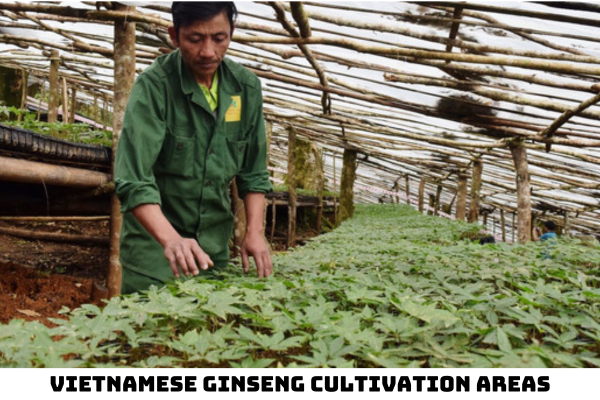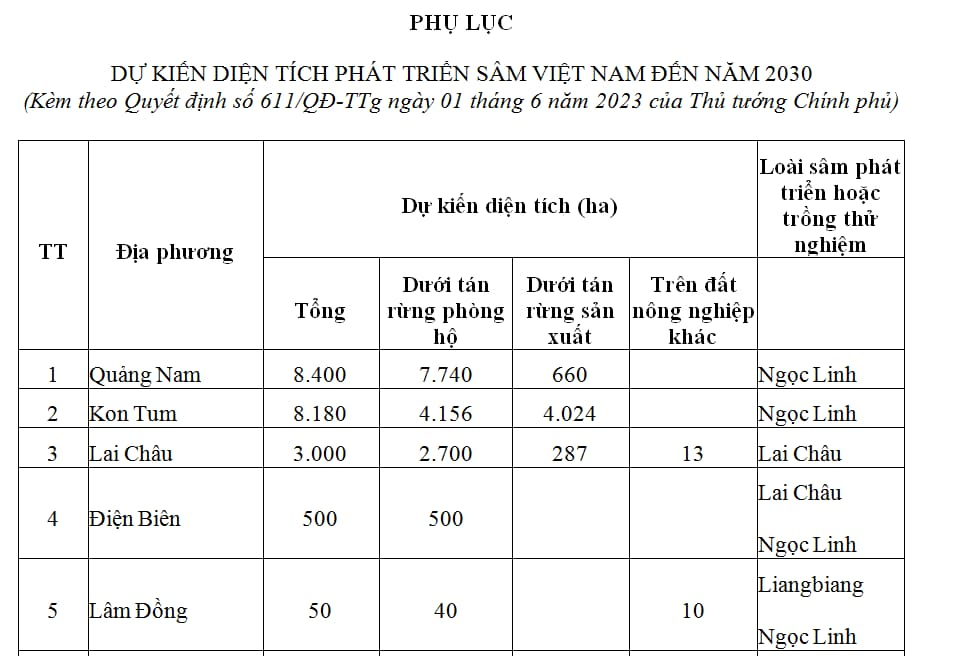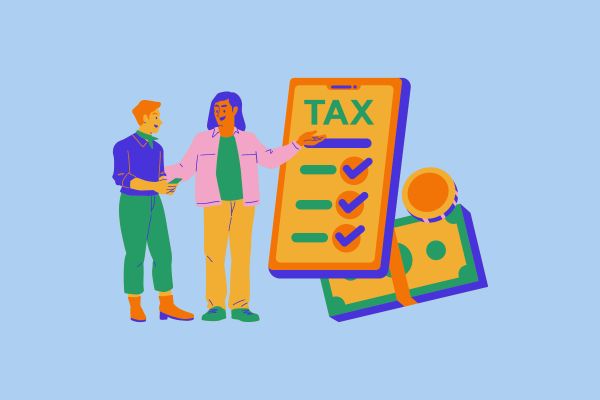Is it required to strive to expand Vietnamese ginseng cultivation areas to an area of roughly 21,000 hectares in 2023 and make Vietnam a significant global ginseng producer?
- Under the new decision, is it required to strive to expand Vietnamese ginseng cultivation areas to an area of roughly 21,000 hectares in 2023 and make Vietnam a significant global ginseng producer?
- What are the scope and subjects of the Vietnamese Ginseng Development Program? What is the time for the implementation of the Program?
- What are the tasks and solutions proposed in the Vietnamese Ginseng Development Program?
On June 1, 2023, the Prime Minister of Vietnam has just signed Decision 611/QD-TTg in 2023 approving the Vietnamese Ginseng Development Program to 2030, with orientation to 2045.

Under the new decision, is it required to strive to expand Vietnamese ginseng cultivation areas to an area of roughly 21,000 hectares in 2023 and make Vietnam a significant global ginseng producer?
In Decision 611/QD-TTg in 2023, the specific objectives of 02 stages are specified as follows:
* By 2030:
- Conserve Vietnamese ginseng gene resources in the wild in association with forest protection and development, biodiversity conservation in forest ecosystems;
- Strive to expand Vietnamese ginseng cultivation areas to an area of roughly 21,000 hectares in 2023, and reach 100% of the Vietnamese ginseng cultivation area granted cultivation area codes and geographical indications.
- Reach about 300 tons/year in the exploitation output of Vietnamese ginseng from 2030 (exploitation area is about 1,000 ha/year), ensuring origin, meeting GACP - WHO standards (good farming and harvesting practices) or equivalent.
- Invest in and develop facilities for preliminary processing and deep processing of Vietnamese ginseng products associated with raw material areas, and production chains, of which about 50% of production facilities meet GMP-WHO quality standards (good manufacturing practices).
* Orientation to 2045:
- Develop Vietnamese Ginseng into an internationally branded product with high export value, creating a major source of revenue for localities, striving to make Vietnam a significant global ginseng producer.
Thus, is it required to strive to expand Vietnamese ginseng cultivation areas to an area of roughly 21,000 hectares in 2023, reach 100% of the Vietnamese ginseng cultivation area granted cultivation area codes and geographical indications in the period to 2030, and develop Vietnamese Ginseng into an internationally branded product with high export value, creating a major source of revenue for localities, striving to make Vietnam a significant global ginseng producer by 2045.
What are the scope and subjects of the Vietnamese Ginseng Development Program? What is the time for the implementation of the Program?
According to Section III, Article 1 of Decision 611/QD-TTg of 2023:
* Scope
- Localities with potential and strengths in natural conditions suitable for the cultivation and development of Vietnamese Ginseng, including the provinces of Quang Nam, Kon Tum, Gia Lai, Lam Dong, Thua Thien Hue, Nghe An, Lao Cai, Lai Chau, Dien Bien. In particular, developing Vietnamese ginseng raw material areas at the commodity scale in the provinces of Quang Nam, Kon Tum, and Lai Chau.
* Subjects
- Ginseng species that Vietnam conserves, cultivates, and develops
+ Subjects of conservation, development, processing, and trade at commodity scale: Panax vietnamensis Ha et Grushv, Panax vietnamensis var. fiscidiscus K.Komatsu, S.Zhu & S.Q.Cai.
+ Subjects of conservation, cultivation and development of experimental scale: LangBiang Ginseng (Panax vietnamensis var. langbianensis N.V.Duy, V.T.Tran&L.N.Trieu) and Puxailaileng Ginseng (Panax sp) in areas with suitable natural conditions.
- The proposed land fund for the cultivation and development of Vietnamese Ginseng for production and business purposes under this Program includes: cultivating and developing under the canopy of protective forests, forests produced by combined forestry and agricultural production methods in accordance with the provisions of the law on forestry, land for agricultural crops.
* Implementation time
- Phase I: from 2023 to the end of 2030.
- Phase II: by 2045, developed on the basis of evaluating the results of phase I implementation.
What are the tasks and solutions proposed in the Vietnamese Ginseng Development Program?
In Section IV, Article 1 of Decision 611/QD-TTg in 2023, the key tasks include:
- Conserve and develop Vietnamese ginseng:
+ Develop a database system on the conservation and development of gene resources of Vietnamese Ginseng species and identifying suitable growing areas.
- Research, select, create and produce Vietnamese ginseng seeds:
+ Research, select, and breed Vietnamese Ginseng, focusing on selecting and creating varieties of Panax vietnamensis Ha et Grushv, Panax vietnamensis var. fiscidiscus K.Komatsu, S.Zhu & S.Q.Cai with high yield, quality, and resistance to pests and diseases.
- Develop concentrated Vietnamese Ginseng raw material areas:
+ - Cultivate and develop Vietnamese Ginseng Raw Material areas with an area of about 21,000 ha in the provinces of Quang Nam, Kon Tum, Gia Lai, Lam Dong, Thua Thien Hue, Nghe An, Lao Cai, Lai Chau, Dien Bien with climatic and soil conditions suitable to the ecological requirements of Vietnamese Ginseng. The specific scale and location are determined on the basis of a thorough assessment of potential, investment capacity, land fund, economic, social, and environmental efficiency, and market demand. (details in the attached Appendix). DOWNLOAD

- Promote the sustainable processing and trading of Vietnamese ginseng products along the value chain:
+ Develop and diversify Vietnamese ginseng products along the value chain, reaching about 50-80 products by 2030; develop product introduction and distribution channels at home and abroad.
- Develop brand and market, conduct trade promotion:
- Support the construction, brand registration, and development of Vietnamese ginseng products domestically and internationally.
- Associate the infrastructure development of Vietnamese Ginseng cultivation areas with the infrastructure development of ethnic minorities and mountainous regions:
- Invest in and upgrade transport and electricity systems to connect to districts and communes with concentrated Vietnamese ginseng raw material areas and processing facilities in provinces participating in the Program through integrating the implementation of programs and public investment capital.
- Invest in other essential infrastructure for the production, processing, and consumption of Vietnamese ginseng products.
Thus, the Vietnamese Ginseng Development Program has set out 06 tasks to implement in the 2030-2045 period.
See details of the tasks here Decision 611/QD-TTg of 2023 Download
At the same time, in Section V Article 1 of Decision 611/QD-TTg in 2023, the solutions of the Vietnamese Ginseng Development Program include:
- On science and technology
- On the organization of production
- On the market development
- On mechanisms and policies
- On international cooperation
See solution details of Decision 611/QD-TTg of 2023 Download
LawNet
